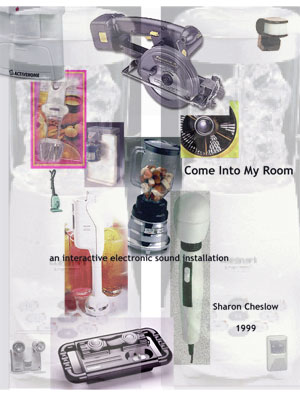|
Come Into My Room text score (1999)
This sound installation explores the boundaries inherent in the following areas: art exhibit vs. musical performance, domestic electronic technology vs. electronic musical instrumentation, public vs. private space, viewer vs. viewed, and female vs. male voice/experience.
 The installation is not site specific, although it is important for it to be in a room that brings to mind either a performance space or an art installation space. This is so the boundaries are blurred between musical performance and art exhibition. The audience enters the room not knowing if what they are seeing and hearing is “art” or “music” because the art objects (i.e.-the appliances) create sound, and the musical objects (i.e.-the musicians) are designed as part of the installation space and, as such, are works of art. The appliances serve as both objects of art and instruments of sound. The appliances are hung or displayed near the walls for people to observe as art, and yet they are also sound producing objects which create a variety of timbres, rhythms and drones as the pairings are turned on and off. The installation is not site specific, although it is important for it to be in a room that brings to mind either a performance space or an art installation space. This is so the boundaries are blurred between musical performance and art exhibition. The audience enters the room not knowing if what they are seeing and hearing is “art” or “music” because the art objects (i.e.-the appliances) create sound, and the musical objects (i.e.-the musicians) are designed as part of the installation space and, as such, are works of art. The appliances serve as both objects of art and instruments of sound. The appliances are hung or displayed near the walls for people to observe as art, and yet they are also sound producing objects which create a variety of timbres, rhythms and drones as the pairings are turned on and off.
The electronic household appliances are transformed into instruments of sound, beautiful and abrasive sounds that are taken for granted since they are heard on a daily basis. New sounds are created by the combination of two appliances played in tandem, as well as by the juxtaposition of the various pairings. These sounds are contrasted with the sounds from the electronic instrument, which at times parallel each other and at other times create overtones and harmonics.
The installation room emulates a domestic space by the use of appliances associated with domesticity or the private space of female experience (kitchen, bathroom, bedroom). The audience enters the woman’s space and interacts with her as well as her everyday experience. And yet the audience is also in a public space with free access to anyone who chooses to enter, blurring the boundaries between a woman’s private and public experience.
In most cases, the dynamic of performer/audience and exhibit/art spectator creates a hierarchy whereby the audience/spectator views what is in front of them passively, consuming the experience as a product. In this installation, instead of observing the musicians or the objects of art (i.e.-the appliances) from a distance, individuals are involved as soon as they enter the room. A discourse is created whereby the audience becomes part of the installation space and performance via the use of motion sensors which allow the audience to turn the appliances on and off.
I wanted this discourse to be based on a woman’s use of electronic technology, by appropriating electronic appliances that are used domestically, and by having the female musician play an electronic instrument. The male and female musician, then, represent the male and female voice. The female musician is the focal point of the installation. She is first seen as people enter the room. She initiates the ritual to end the performance. In essence, it is her room that is being entered. This is done to explore what it means to be a female performer in the public gaze, since a woman’s experience is constantly mediated by the knowledge that she is in the public gaze as an object.
What does it mean for a woman to perform as people watch? What does it mean for an audience to become part of the performance? Who is in control? Who has the power? This installation attempts to subvert these dynamics by having the audience become an equal part of the musical and artistic experience, and in addition, counteracting the role of female as object by creating a situation whereby the male and female voices are heard collaboratively through improvisation.
This was first exhibited/performed as Come Into My Room at Mills College in 1999. The performers were Sharon Cheslow (guitar, electronics) and Randy Nordschow (trumpet). Subsequent versions sometimes had different titles. |